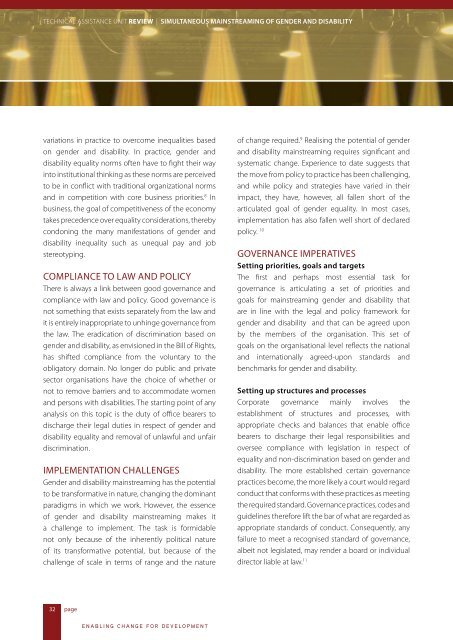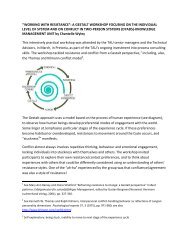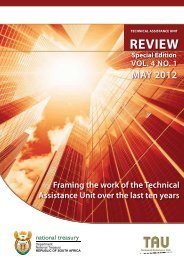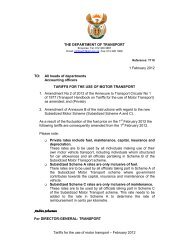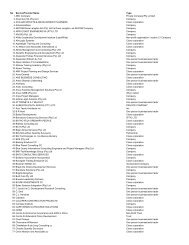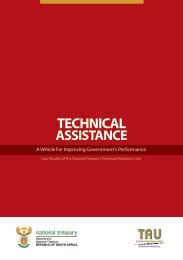Review 3 final 2 - TAU - National Treasury
Review 3 final 2 - TAU - National Treasury
Review 3 final 2 - TAU - National Treasury
Create successful ePaper yourself
Turn your PDF publications into a flip-book with our unique Google optimized e-Paper software.
TECHNICAL ASSISTANCE UNIT REVIEW | SIMULTANEOUS MAINSTREAMING OF GENDER AND DISABILITY<br />
variations in practice to overcome inequalities based<br />
on gender and disability. In practice, gender and<br />
disability equality norms often have to fight their way<br />
into institutional thinking as these norms are perceived<br />
to be in conflict with traditional organizational norms<br />
and in competition with core business priorities. 8 In<br />
business, the goal of competitiveness of the economy<br />
takes precedence over equality considerations, thereby<br />
condoning the many manifestations of gender and<br />
disability inequality such as unequal pay and job<br />
stereotyping.<br />
Compliance to Law and Policy<br />
There is always a link between good governance and<br />
compliance with law and policy. Good governance is<br />
not something that exists separately from the law and<br />
it is entirely inappropriate to unhinge governance from<br />
the law. The eradication of discrimination based on<br />
gender and disability, as envisioned in the Bill of Rights,<br />
has shifted compliance from the voluntary to the<br />
obligatory domain. No longer do public and private<br />
sector organisations have the choice of whether or<br />
not to remove barriers and to accommodate women<br />
and persons with disabilities. The starting point of any<br />
analysis on this topic is the duty of office bearers to<br />
discharge their legal duties in respect of gender and<br />
disability equality and removal of unlawful and unfair<br />
discrimination.<br />
Implementation challenges<br />
Gender and disability mainstreaming has the potential<br />
to be transformative in nature, changing the dominant<br />
paradigms in which we work. However, the essence<br />
of gender and disability mainstreaming makes it<br />
a challenge to implement. The task is formidable<br />
not only because of the inherently political nature<br />
of its transformative potential, but because of the<br />
challenge of scale in terms of range and the nature<br />
of change required. 9 Realising the potential of gender<br />
and disability mainstreaming requires significant and<br />
systematic change. Experience to date suggests that<br />
the move from policy to practice has been challenging,<br />
and while policy and strategies have varied in their<br />
impact, they have, however, all fallen short of the<br />
articulated goal of gender equality. In most cases,<br />
implementation has also fallen well short of declared<br />
policy. 10<br />
Governance Imperatives<br />
Setting priorities, goals and targets<br />
The first and perhaps most essential task for<br />
governance is articulating a set of priorities and<br />
goals for mainstreaming gender and disability that<br />
are in line with the legal and policy framework for<br />
gender and disability and that can be agreed upon<br />
by the members of the organisation. This set of<br />
goals on the organisational level reflects the national<br />
and internationally agreed-upon standards and<br />
benchmarks for gender and disability.<br />
Setting up structures and processes<br />
Corporate governance mainly involves the<br />
establishment of structures and processes, with<br />
appropriate checks and balances that enable office<br />
bearers to discharge their legal responsibilities and<br />
oversee compliance with legislation in respect of<br />
equality and non-discrimination based on gender and<br />
disability. The more established certain governance<br />
practices become, the more likely a court would regard<br />
conduct that conforms with these practices as meeting<br />
the required standard. Governance practices, codes and<br />
guidelines therefore lift the bar of what are regarded as<br />
appropriate standards of conduct. Consequently, any<br />
failure to meet a recognised standard of governance,<br />
albeit not legislated, may render a board or individual<br />
director liable at law. 11<br />
32<br />
page<br />
Enabling change for development


